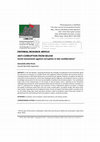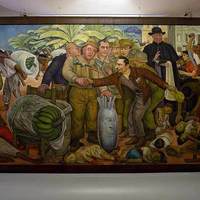Articles, Chapters & Papers by Donatella Della Porta
This volume analyses the genesis and evolution of movement parties during the Great Recession. B... more This volume analyses the genesis and evolution of movement parties during the Great Recession. Bridging social science literature on social movements and political parties, it empirically analyses cases such as Podemos, Syriza and the Five Star Movement

In the last decades, a growing awareness has emerged in progressive social movements about the re... more In the last decades, a growing awareness has emerged in progressive social movements about the relevance of corruption as a hidden factor that negatively influences political and economic decision-making processes in both liberal-democratic and authoritarian regimes. Rampant corruption has been denounced by social movements, which have developed specific diagnostic and prognostic frames as well as knowledge and practices for the social accountability of political and economic powers. This contribution maps some of the characteristics of civil society as anti-corruption actors, reflecting on the theoretical challenges they present for social movement theory and for research on corruption and anti-corruption. In order to understand the emergence and outcomes of these mobilizations against corruption, it bridges two bodies of literature which have only very rarely crossed paths: corruption studies and social movement studies. Departing from the traditional visions of anti-corruption from below within corruption studies , the article brings upon social movement studies in order to synthetize some of the main context, organizational forms and framing of (anti-)corruption in today's contentious politics.

, four meeting points for protesters are set in four areas of Cairo, including working-class neig... more , four meeting points for protesters are set in four areas of Cairo, including working-class neighbourhoods. Before moving towards the city centres, the marchers travel through narrow residential streets, gathering participants on their way. Marches thus create physical occasions to join, then carry participants to their destination. As a protester puts it, 'You ' re taken to Tahrir by the demonstration itself as the head of the march guides it there' (El Chazli 2012). Spontaneous demonstrations follow in the next two days, including confrontations with police. On 28 January, a Friday of Rage is called for, with various demonstrations starting from mosques and churches. While the police assail the protesters with substantial use of teargas, the protesters attack police headquarters as well as the headquarters of the regime party. After that, the camps set up by protesters in Tahrir Square attract more and more people. On 15 May 2011, indignant citizens (whom the media called Indignados) start a permanent occupation of Puerta del Sol in Madrid, building a tent city for hundreds of protesters, but also other infra-structures for thousands of visitors. The mobilization quickly spreads to hundreds of Spanish cities all around the country. In fact, 'the encampments rapidly evolve into " cities within cities " ', governed through popular assemblies and committees. The committees are
Introduction to the Oxford Handbook of Social Movements
Mainstream social movement studies have developed a useful kit of concepts and theories, well ada... more Mainstream social movement studies have developed a useful kit of concepts and theories, well adapted to understanding social movements in core capitalist countries at the peak of growth of the welfare state. Widespread assumptions about the role of political opportunities, resource mobilization and framing processes need to be updated to make sense of contentious global politics in the 2000s, in particular, adding a focus on the socioeconomic conditions for protests. In order to illuminate research results about the social basis of anti-austerity protests, the article critically reviews some recent contributions to political economy. In particular, some of the most influential contributions within Marxist and post-Marxist approaches to relevant capitalist transformations are discussed, with reflections on different temporalities in capitalist transformations.

This chapter brings in a relational perspective to the structure and agency across the Gezi Park ... more This chapter brings in a relational perspective to the structure and agency across the Gezi Park uprisings in Turkey. In order to understand the social and political dynamics that played out in the course of the mobilizations, we discuss and critically elaborate the relation of class, authoritarian rule, and contentious politics to the agency of the protests. Drawing on in-depth interviews with organizationally affiliated and unaffiliated protesters, protest event analysis, public surveys, and official documents, the chapter shows how public outrage at the government's political encroachments into particular lifestyles, values, and orientations helped an ongoing urban resistance evolve into a mass rebellion. By focusing on the eventful characteristics of the protests, we also delve into the political subjectivities that have been activated, contested, transformed and in the making since the eruption of the uprisings.

This chapter brings in a relational perspective to the structure and agency across the Gezi Park ... more This chapter brings in a relational perspective to the structure and agency across the Gezi Park uprisings in Turkey. In order to understand the social and political dynamics that played out in the course of the mobilizations, we discuss and critically elaborate the relation of class, authoritarian rule, and contentious politics to the agency of the protests. Drawing on in-depth interviews with organizationally affiliated and unaffiliated protesters, protest event analysis, public surveys, and official documents, the chapter shows how public outrage at the government's political encroachments into particular lifestyles, values, and orientations helped an ongoing urban resistance evolve into a mass rebellion. By focusing on the eventful characteristics of the protests, we also delve into the political subjectivities that have been activated, contested, transformed and in the making since the eruption of the uprisings.

Si la globalización – concepto impreciso y criticado – redefine las características de los movi... more Si la globalización – concepto impreciso y criticado – redefine las características de los movimientos abasteciendo una serie de oportunidades para la movilización en escala transnacional, ella también define una serie de vínculos para la acción de los movimientos sociales. Los movimientos se encuentran para interactuar con una serie de actores diversos sobre el tablero global: nuevos desafíos surgen en la esfera económica con el creciente peso asumido por las empresas multinacionales, nuevas contrapartes institucionales ocupan la esfera política después de la multiplicación de las organizaciones gubernametanles internacionales (OGI) y nuevos conflictos han surgido en la esfera cultural alrededor de la definición de los problemas políticos, con la afirmación de los medios de comunicación privados globales.
El movimiento antiliberal se encuentra operando en un sistema extremadamente complicado en el cual no sólo los lugares, sino también los actores que asumen decisiones importantes son múltiples o actúan en esferas distintas y sobre niveles territoriales diferentes. Por lo tanto, los movimientos buscan individuar distintas estrategias, para tener una mayor probabilidad en la obtención de resultados. Pero, ¿cuáles son las reacciones puestas en acción por los movimientos sociales transnacionales para reaccionar a los nuevos desafíos que se manifiestan en el nivel económico, político y cultural? Como se argumenta en este capítulo, los movimientos reaccionan entretejiendo una multiplicidad de estrategias: desde los boicots, pasando por la organización de contravértices, hasta la creación de instrumentos propios de información y comunicación alternativa.
The chapter begins with a brief overview of our methodology, followed by a brief historical summa... more The chapter begins with a brief overview of our methodology, followed by a brief historical summary of protest time in Italy and a breakdown of the types and actors of protest in Italy in 2011. We then focus on democracy, then on Europe, drawing on the results of our frame analysis and survey data. Our conclusions develop the idea of the ideals and practices of the Indignados and Occupy movements finding their expression via different groups in the Italian context, in particular the referendum campaign, citizens’ movements against large-scale infrastructure projects but also the many labour conflicts – against factory closures, dismissals and worsening market and labour conditions taking place throughout the year.
Nel presente saggio l’attenzione è posta su alcuni dei principali conflitti locali emersi in Ita... more Nel presente saggio l’attenzione è posta su alcuni dei principali conflitti locali emersi in Italia dalla metà degli anni Novanta: le proteste dei comitati spontanei di cittadini, le campagne contro la TAV in Valle di Susa in Piemonte e contro il ponte sullo Stretto di Messina, le mobilitazioni dei social forum locali. Nella parte conclusiva si presenta un’analisi degli eventi di protesta che hanno caratterizzato il biennio 2011-12, formulando alcune ipotesi sull’apparente e paradossale assenza di conflitto in un contesto che sembrerebbe invece particolarmente favorevole all’emergere della protesta.
Rassegna Italiana di Sociologia, Jan 1, 2006
Ricercando nella rete: stili democratici dei siti web del movimento per una giustizia globale di ... more Ricercando nella rete: stili democratici dei siti web del movimento per una giustizia globale di Donatella Della Porta e lorenzo Mosca 1. Internet e movimenti sociali: una introduzione Secondo me in realtà questi strumenti sono stati fondamentali per determinare dei cambiamenti o per determinare una maggiore o diversa consapevolezza nella società […]
Globalización, movimientos sociales y protesta. DSpace/Manakin Repository. Search Cadmus. Search ... more Globalización, movimientos sociales y protesta. DSpace/Manakin Repository. Search Cadmus. Search Cadmus This Collection. Advanced Search. Browse. ...

Global Networks, Jan 1, 2007
In this article we explore the process of ‘contamination’ (namely cross-fertilization) in the de... more In this article we explore the process of ‘contamination’ (namely cross-fertilization) in the development of the Global Justice Movement in Italy during the 1990s. We focus on two specific organizational sectors of this movement: labour organizations and associations for solidarity with the global South. We concentrate on a stage of the protest cycle that has been overlooked in social movement studies, namely the emergence of mobilization after a period of latency, and shed light on the process through which individual and organizational networks actually facilitate mobilization and vice versa. The process of ‘contamination’ in action is presented as the combination of structural, cognitive and affective mechanisms. It operates through both individual and organizational networks that together facilitate logistic coordination, enable the emergence of tolerance and mutual trust and allow frame bridging and the transnationalization of identities.

Rassegna italiana di sociologia, Jan 1, 2003
Movimenti sociali e sfide globali: politica, antipolitica e nuova politica dopo l'11 settembre di... more Movimenti sociali e sfide globali: politica, antipolitica e nuova politica dopo l'11 settembre di DONATELLA DELLA PORTA, MASSIMILIANO ANDRETTA e LORENZO MOSCA Dopo gli attentati alle Torri Gemelle, la risposta del fronte pacifista italiano è imponente (nel nostro paese si svolgeranno infatti le manifestazioni più partecipate contro il terrorismo e contro la guerra), anche se non unitaria. A una serie di fiaccolate e manifestazioni cittadine in tutta la penisola, segue la prima mobilitazione nazionale che viene fatta coincidere con la marcia per la pace Perugia-Assisi. Nell'appello della Tavola della Paceche convoca la marcia -si legge «noi, donne e uomini delle Nazioni Unite, marceremo lungo la strada che da Perugia conduce ad Assisi per promuovere la globalizzazione dei diritti umani, della democrazia e della solidarietà. [...]) Ci muove la consapevolezza che non ci sono processi inevitabili, che "un altro mondo è possibile" e che per costruirlo è necessario promuovere la globalizzazione dal basso» (Tavola della Pace 2001). L'appello mostra quindi, fin dalle prime battute, una chiara adesione agli obiettivi del movimento che ha contestato il vertice del G8 a Genova. L'appello contiene una serie di richieste indirizzate alle principali istituzioni italiane ed europee e all'assemblea generale delle Nazioni Unite.











Uploads
Articles, Chapters & Papers by Donatella Della Porta
El movimiento antiliberal se encuentra operando en un sistema extremadamente complicado en el cual no sólo los lugares, sino también los actores que asumen decisiones importantes son múltiples o actúan en esferas distintas y sobre niveles territoriales diferentes. Por lo tanto, los movimientos buscan individuar distintas estrategias, para tener una mayor probabilidad en la obtención de resultados. Pero, ¿cuáles son las reacciones puestas en acción por los movimientos sociales transnacionales para reaccionar a los nuevos desafíos que se manifiestan en el nivel económico, político y cultural? Como se argumenta en este capítulo, los movimientos reaccionan entretejiendo una multiplicidad de estrategias: desde los boicots, pasando por la organización de contravértices, hasta la creación de instrumentos propios de información y comunicación alternativa.
El movimiento antiliberal se encuentra operando en un sistema extremadamente complicado en el cual no sólo los lugares, sino también los actores que asumen decisiones importantes son múltiples o actúan en esferas distintas y sobre niveles territoriales diferentes. Por lo tanto, los movimientos buscan individuar distintas estrategias, para tener una mayor probabilidad en la obtención de resultados. Pero, ¿cuáles son las reacciones puestas en acción por los movimientos sociales transnacionales para reaccionar a los nuevos desafíos que se manifiestan en el nivel económico, político y cultural? Como se argumenta en este capítulo, los movimientos reaccionan entretejiendo una multiplicidad de estrategias: desde los boicots, pasando por la organización de contravértices, hasta la creación de instrumentos propios de información y comunicación alternativa.
ENGLISH: This article looks at the little studied relationship between social movements, cycles of protest, waves of strikes and transnational advocacy networks of resistance to non-democratic regimes in democratization processes. It first focuses on views of social movements within the democratization literature, pointing at the limited role assigned to them in the main approaches: modernization theory, historical class perspective and transitology. It then moves to address visions of democratization within the social movement literature, where the new social movements approach emphasizes the innovative, post-materialist dimension and non-state centric characteristic of movements during democratization; and the political process approach considers democratization as a product of the interaction between elite negotiations and mobilization processes. After reviewing these different perspectives, the authors propose an analytic organization of the different roles that social movements, trade unions, advocacy networks, and cycles of protest play in the dynamic, contingent and contentious shaping of democracy. In the discussion of these topics, Latin American, Southern European and Eastern European cases are used to illustrate the diverse roles played by social movements, depending on the type of democratization process and the stage in which they mobilize (resistance, liberalization, transition, consolidation, expansion)."
Looking at a huge variety of subnational examples across Italy, Spain and France, the book interrogates the rich findings of a substantial research project. The authors use quantitative and qualitative methods to compare why these cases of participatory mechanisms have emerged, how they function, and what cultural impact they’ve achieved. This allows highly original insights into why participatory mechanisms work in some places, but not others, and the sorts of choices that organizers of participatory processes have to consider when creating such policies."
Presenting the first systematic empirical research on the global justice movement, Globalization from Below analyzes a movement from the viewpoints of the activists, organizers, and demonstrators themselves. The authors traveled to Genoa with anti-G8 protesters and collected data from more than 800 participants. They examine the interactions between challengers and elites, and discuss how new models of activism fit into current social movement work.
The book represents a thorough and thoughtful account about how this movement has operated, and how it reflects well-established theoretical thinking about social movements. It is indisputable that the global movement is one of the most important political developments of our time. Anyone who studies social movements, protest, democracy, and governance cannot afford to be uninformed about his movement. Thus, the empirical account of these important protest sequences, which helped to proved the fundamental definition, identity, and agenda for this movement, is invaluable in its own right. Furthermore, the creative use of data to examine the development and adoption of frames is a worthy example for others, and the elaboration of ideas about protest control is informative and stimulating.
—
American Journal of Sociology
This is the first book we know of on the World Social Forum process that specifically addresses a nonspecialist U.S. audience
Many of the book’s authors are well-known experts in the fields this book addresses
The book’s multiple authors have participated in all of the World Social Forums and in many regional and local ones, offering a unique approach to analyzing this major global phenomenon
The World Social Forum is the most happening event on the planet and Americans are just starting to learn about it
This is a perfect handbook for those interested in social activism in the contemporary world
Leading scholars wrote this book for a general readership including activists and students to alert them to the World Social Forum, currently the most significant global political event